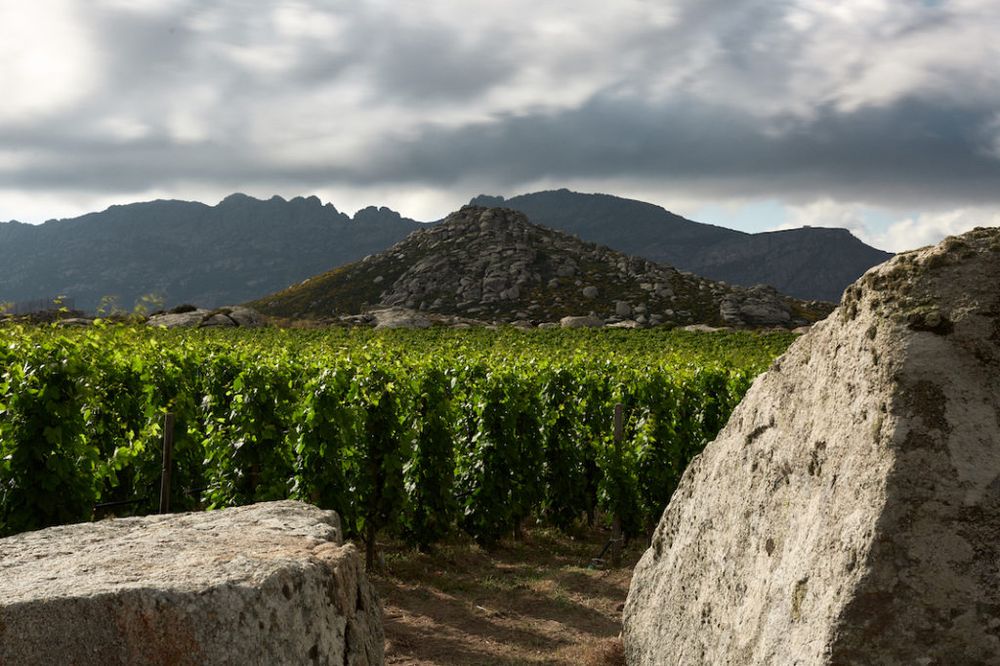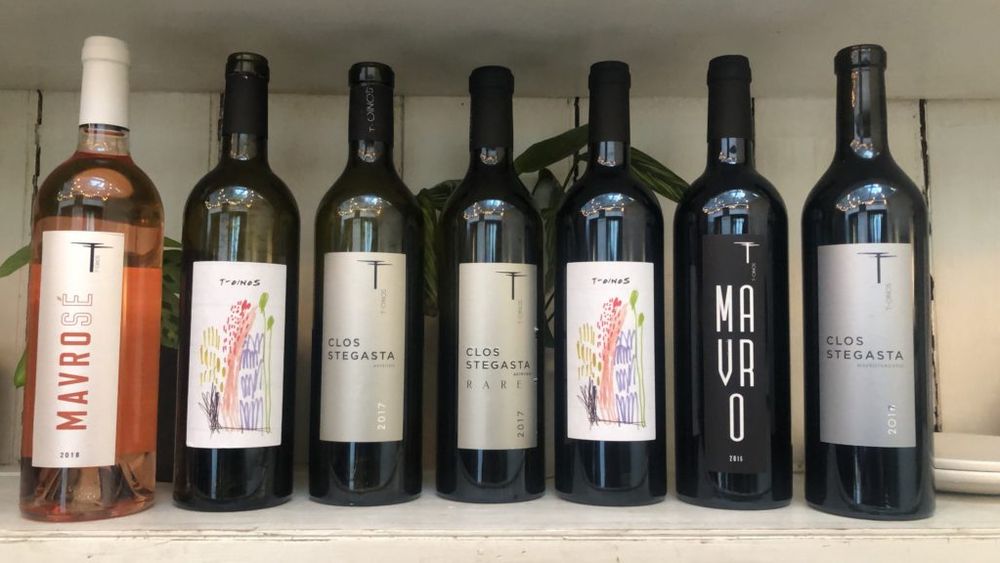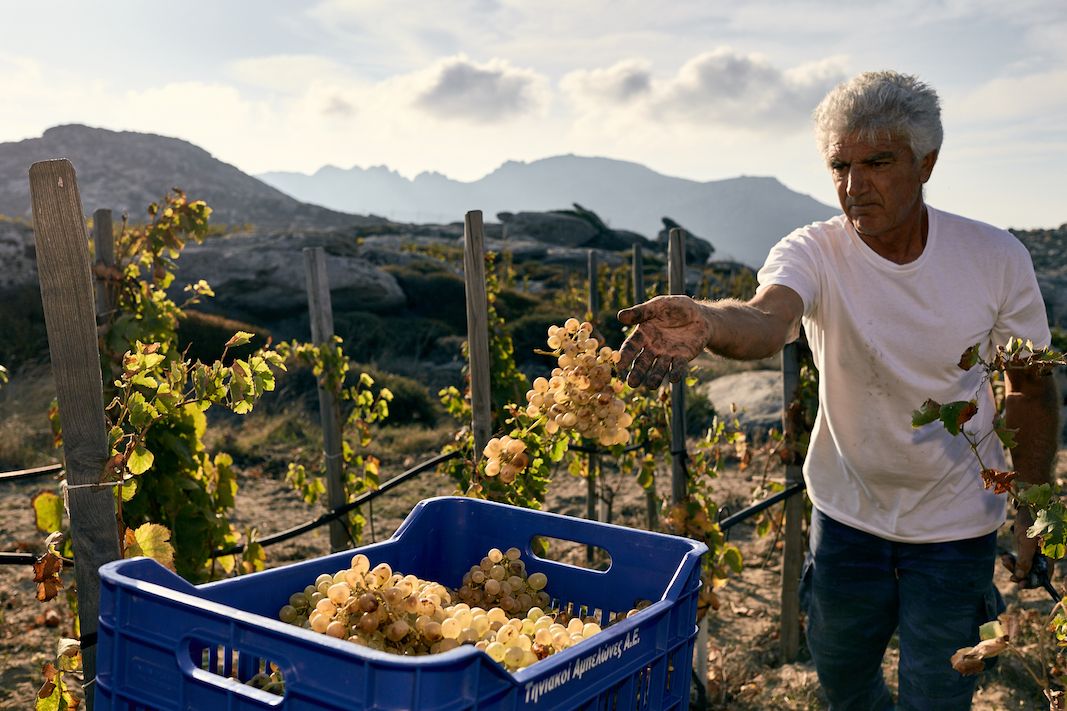Mavrotragono, the very dark-skinned grape variety, which hails originally from Santorini, is perfect for the Tinos terroir, believes Derenoncourt.
Wine writers are always on the lookout for the next big thing. And many have drawn attention to ‘heroic winemaking’, emphasising the extreme difficulties involved in getting vines to behave properly in tough terrain and drawing attention to the sometimes impressive results.
Heroic winemaking has a long history in such places as Valtellina, Alto Piemonte, Pico in the Azores, where remarkable viticultural efforts in pumice-walled vineyards have enabled the revival of ancient varieties like Terrantez do Pico. Then there is Santorini, whose volcanic soil reflects the fact that even long before the vast Minoan era-explosion, Thira lay at the heart of a major volcanic chain.

The beautiful, wild and windy Greek island of Tinos
But the T-Oinos winery on the Cyclades island of Tinos is something quite different. According to Konstantinos Lazarakis MW, in his recent Wines of Greece these well-regarded high end wines have an extraordinary pedigree.
“A complete outsider (Alexandros Avatangelos) went into a region with no wine quality credentials in modern history and created a gem with no expenses spared.”
It did help, of course, that the team that planted the vines back in 2002 and then nurtured them to productive health included the famous Bordeaux-based flying winemaker Stéphane Derenoncourt, whose other clients include Paydos in Toro, Weingut Estérhazy in Austria and, closer by, Argyros in Santorini. Derenoncourt has been involved since 2017 but other key people who played important roles in the birth of T-Oinos include oenologist Thanos Fakorelis and Gerard Margeon, the wine director/head sommelier at Alain Ducasse, whose restaurants have served as a showcase for the wines and helped them attain their iconic status.

Derenoncourt addresses press and sommeliers, London, May, 2019
But it was a tough road, as Derencourt explained to me in early May at a lunch to launch the wines into the UK market.
“The biggest problem is the wind (according to Greek legend, Tinos was home to the God of Winds) which never seems to stop. You have to protect the vines against it,” he says.
Derenencourt says another problem is the soil – granitic, yes, but generally of such poor quality that the vines really struggle.
So why did he bother to get involved?
“That’s easy. Because the place is so beautiful. You have to see it and experience it to realise just how much.”
Four Greek varieties are grown at T-Oinos, white Assyrtiko and Malagousia and red Mavrotragano and Avgoustiatis and the winery now has six labels (including a rosé made from Mavrotragano). Unsurprisingly perhaps, given the cost and logistical difficulties, production is just 18,000-20,000 bottles, of which 65% is white. All are organic.
“We have the potential to go to 30,000 but the focus is on maintaining quality and low yields,” says Derenencourt. Some 60% of production stays in Greece (including in Tinos, which has three other producers) with the rest going to France, Japan and now, of course, the UK.
So what were the wines tasting like?

Tasting through the wines, the whites are very rich but with good acidity with the Malagouzia 2018 showing the roundness and vanilla tones often associated with the variety. More impressive – naturally – are the flagship Clos Stegasta whites, the Assyrtiko 2017 and the Assyrtiko 2017 Rare, so called because the grapes come from the oldest Clos Stegasta vines, located in the centre of Tinos, some 450 metres above sea level. Both wines are exceptionally rich and full, without the bracing acidity of some Santorini Assyritikos, but with delicious minerality and herbal/floral flavours on the palate. Fermented via indigenous yeasts the wines lie on the lees for six months before spending time in large oak barrels and bottling.
If anything, the reds were more impressive, showing the wide range of what T-Oinos is now capable. The Avgoustiatis is made, according to Derenencourt, in an easy drinking Gamay style to give a good expression of terroir; gentle pressing, short maceration and ageing in large oak barrels make this medium weight wine very approachable and decidedly moreish.
The other two reds the Mavro 2016 and the Clos Stegasta Mavrotragono 2017 (though both wines are made from the latter variety) are very rich and elegant, lots of pepper and spice, with black cherry flavours and great balance. The wines, which also have great length, confirm Derenencourt’s belief that the very dark-skinned variety, which hails originally from Santorini, is perfect for the Tinos terroir.

“These wines are different but both perfect expressions of the variety,” he says, noting that the Mavro comes from vines grown on sandy loam, whilst the Mavrotragano – which is only made in vintages when the conditions are just right – is grown on sandy clay with granite bedrock.
Certainly, the wines have impressed Berkmann Wine Cellars who have signed T-Oinos as their first Greek agency. Although the group plans to sign other wineries, to reflect the growing interest in and popularity of Greek wine in the UK trade, T-Oinos represents a great starting point.
“These are exactly the sort of iconic wines that we want to promote,” says Guillem Kerambrun, Berkmann’s recently appointed director of fine wine.
T-Oinos wines are available through Berkmann and priced between £15.50 and £64
































